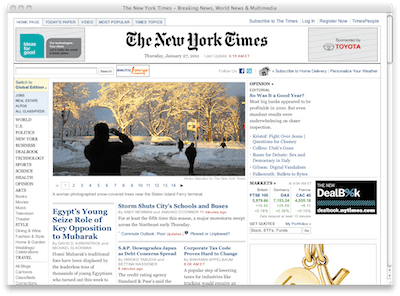Readability is a subscription based service that allows you to read the text off of websites in a beautiful, clean, consistent interface. Since I started reading the web through Readability a while ago, I’ve appreciated it’s consistency, meaning that one site looks the same as the next, as the next, and the next. Reading articles on the web becomes more about the writing, and less about design. Jumping from site to site can be jarring, distracting, but when using Readability, the entire web can feel like a single book, one with many chapters.
However, I’ve been able to achieve this consistency with Safari Reader (yes, I know it’s built off of Readability), and Instapaper text view (yes, also inspired by Readability). So, the discussion is not about the value of the Readability service, since you can get the same thing for free, but who should pay for the content rendered through Readability. Advertisers… or you?
Do you feel generous?
I feel that I get value from the sites that I visit, the sites that I’ve marked as “Can’t Miss” in NetNewsWire, and knowing how publishing works on the web, I often visit my favorite sites and click on an ad. That click gives the site money, which ensures (hopefully) that the site will continue to be published and continue to provide me with some kind of value. That value might be entertainment, news, opinion, or instruction, but it is worth something to me. Readability is a way to pay for that value, while reading the site in an interface that makes sense.
Paying for the experience is where Readability differs from Instapaper. In my mind, I think about reading with Readability now, and reading with Instapaper later, but the overlap between the two is too obvious to ignore. Evidently the developers of Readability agree. They have been working with Marco Arment to develop a special build of Instapaper that will credit the sites you read through the Readability service.
Readability has a few surprisingly big names behind it. Not only is Marco onboard, but also Frank Black, Jeffery Zeldman, and more. With a team as talented this, I think its important to think through any criticism of the service carefully. I’m sure they have.
Unfortunately, the current quality of the Readability service is a little less than I would expect. There have been several times in the past couple days I’ve hit the Readability keyboard shortcut and was shown this error.
Going back to the site and trying again fixes the problem. I’m assuming that they are making improvements to the Readability back-end continuously, and that this error is a symptom of those improvements. Annoying, but I’m chalking it up to growing pains.
The second problem I’ve found is when using HyperDock to split the screen of my 15” MacBook Pro between Safari and a text editor, Readability pushes the text off the right side of the Safari window. The last six or so characters are off the screen. Stranger yet, when resizing the window smaller, the horizontal scroll bar does not appear to allow you to scroll to view all of the text, the text is just gone. The Instapaper text bookmarklet does the right thing and formats the text correctly for the current size of the window, and provides the normal scrollbar when needed. I’m not sure why Readability doesn’t, but its just a bit disappointing.
I’m hoping that both of these problems are fixed soon.
Ian Hines is a fan, and had this to say:
It’s a wonderful concept. It’s all the things we’ve come to know and love about Instapaper, with the added ability of finally allowing us to easily support our favorite writers.
In contrast, Colin Wheeler is skeptical:
…for me it feels wrong cause it puts the burden on consumers instead publishers who need to clean up their websites in the first place
What Colin is saying is when a site is well designed, there’s no need for Readability. The sites many people are most likely to read in Readability are the sites that do not understand the value of clean design in the first place, sites that are covered with ads and distractions. He makes an excellent point, and one that I think is going to be shared by a lot of people.
Herein lies the rub. No one likes ads, but no one wants to pay for online content. So how can sites that make their money off of page views continue to exist if they do actually clean up their interface? That’s the answer that Readability is designed for. An alternative revenue stream. It is an interesting test.
Also interesting to note is that Readability is not a startup, it’s an experiment by an established company. Arc90 builds and designs internal applications for other businesses. Richard Ziade, the original creator of Readability, has this to say about why Readability exists:
We also believe that quality content is worth paying for. The rat race for page views and impressions has not only led to an oftentimes painful experience on the web, but also to a diminishing of quality content on the web. Today’s reality isn’t anyone’s fault but ours. We won’t hesitate to spend $4.00 for our daily cup of coffee … but we’ll balk at even a modest attempt at supporting the volumes of content we consume on the web. Readability represents an opportunity to show all the great publications, writers and bloggers out there that we care about quality and we’re willing to pay for it.
Readability may turn out to be more important to the future of the web than we can currently see. I’m rooting for it. I’m rooting for less ads, higher quality, and more thought.
